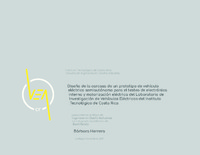Mostrar el registro sencillo del ítem
Diseño de la carcasa de un prototipo de vehículo eléctrico semiautónomo para el testeo de electrónica interna y motorización eléctrica del Laboratorio de Investigación de Vehículos Eléctricos del Instituto Tecnológico de Costa Rica
| dc.contributor.advisor | Araya-Calvo, Miguel | es |
| dc.contributor.author | Herrera-Gutiérrez, Bárbara Haydeé | |
| dc.date.accessioned | 2020-03-24T20:50:12Z | |
| dc.date.available | 2020-03-24T20:50:12Z | |
| dc.date.issued | 2019 | |
| dc.identifier.uri | https://hdl.handle.net/2238/11237 | |
| dc.description | Proyecto de Graduación (Bachillerato en Ingeniería en Diseño Industrial) Instituto Tecnológico de Costa Rica, Escuela de Diseño Industrial, 2019 | es |
| dc.description.abstract | El Laboratorio de Investigación de Vehículos Eléctricos (LIVE), con origen en la Sede Central del Instituto Tecnológico de Costa Rica (ITCR), tiene como meta a largo plazo desarrollar el primer Vehículo Eléctrico Autónomo de Costa Rica (VEA). Para ello, el Ingeniero en Electrónica Eduardo Calvo ha diseñado un Sistema Embebido para el Control de un Vehículo Autónomo a Escala, logrando con éxito que este recorriera una ruta dentro del campus de manera autónoma. Ahora el siguiente reto es transferir este conocimiento a un auto a escala real. Por ello el laboratorio adquirió la donación de un auto usado modelo Honda H4514H, cuyo fin original era cortar césped. Este carro se desmanteló para obtener de él el chasis y tomarlo como la piedra angular del proyecto. Ante esto entra el papel del Ingeniero en Diseño Industrial en diseñar una carcasa que se adapte a este chasis existente, y que además permita el testeo de electrónica interna y motorización eléctrica para transferir el conocimiento del Sistema Embebido para el Control de un Vehículo Autónomo a Escala a escala real. | es |
| dc.description.abstract | The Electric Vehicle Research Laboratory (LIVE), from the Technological Institute of Costa Rica (ITCR), has the long-term goal of developing the first Autonomous Electric Vehicle of Costa Rica (VEA). For this, the Electronics Engineer Eduardo Calvo has designed an Embedded System for the Control of an Autonomous Vehicle at Scale, successfully making it travel a route within the campus autonomously. Now the next challenge is to transfer this knowledge to a real-scale car. Therefore, the laboratory acquired the donation of a used Honda H4514H model car, whose original purpose was to cut grass. This car was dismantled to obtain the chassis from it and take it as the cornerstone of the project. Before this comes the role of the Industrial Design Engineer in designing a housing that adapts to this existing chassis, and that also allows the testing of internal electronics and electric motorization to transfer the knowledge of the Embedded System for the Control of an Autonomous Vehicle at Scale on a real scale. | es |
| dc.language.iso | spa | es |
| dc.publisher | Instituto Tecnológico de Costa Rica | es |
| dc.rights | acceso abierto | es |
| dc.subject | Vehículos eléctricos | es |
| dc.subject | Prototipos | es |
| dc.subject | Carcasa | es |
| dc.subject | Laboratorio de Investigación de Vehículos Eléctricos (LIVE) | es |
| dc.subject | Electric vehicle | es |
| dc.subject | Prototype | es |
| dc.subject | Housing | es |
| dc.subject | Electric Vehicle Research Laboratory (LIVE) | es |
| dc.subject | Research Subject Categories::TECHNOLOGY::Other technology | es |
| dc.subject | Diseño de productos | es |
| dc.subject | Design of products | es |
| dc.title | Diseño de la carcasa de un prototipo de vehículo eléctrico semiautónomo para el testeo de electrónica interna y motorización eléctrica del Laboratorio de Investigación de Vehículos Eléctricos del Instituto Tecnológico de Costa Rica | es |
| dc.type | proyecto fin de carrera | es |


